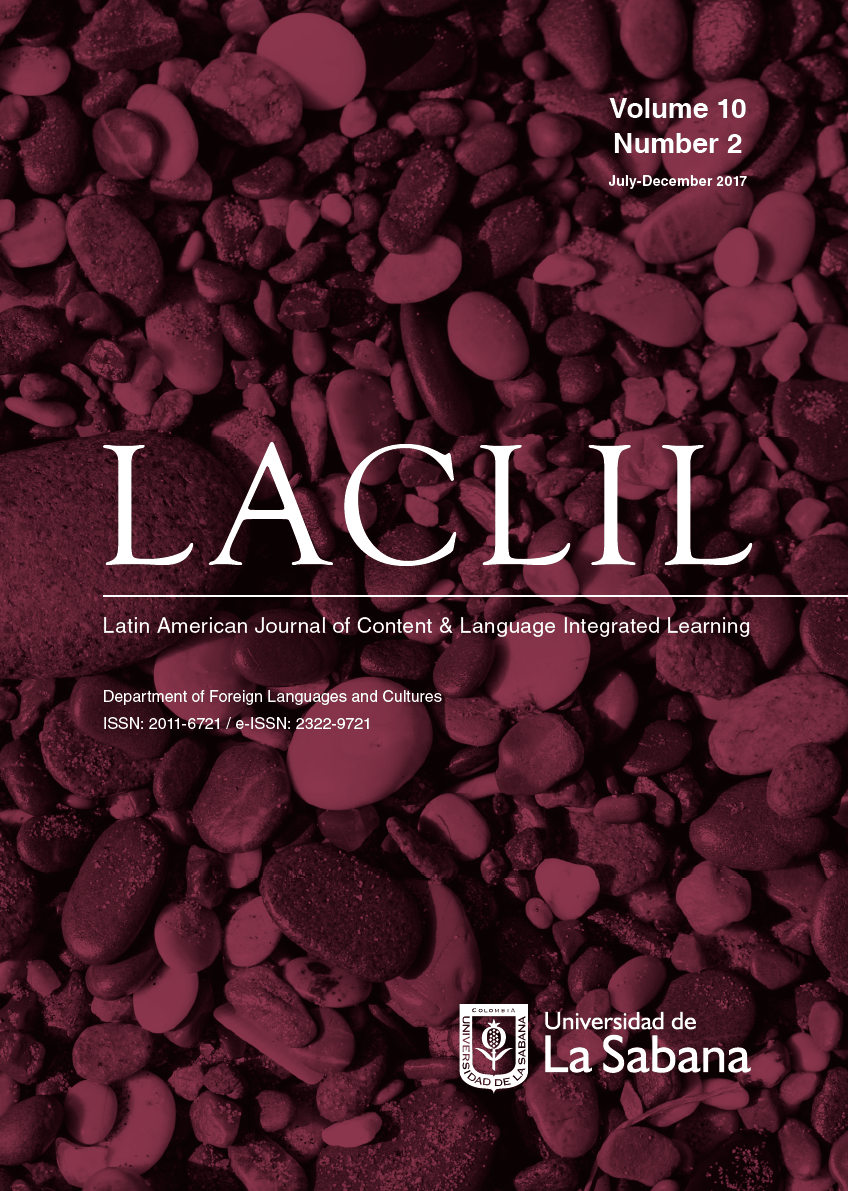Innovating with ICTs in content and language environments
Keywords:
CLIL, ICTs, computer-mediated tasks, science, biology, 21st-Centrury skills.Downloads
References
Abdullahi, H. (2013). The role of ICT in teaching science education in schools. International Letters of Social and Humanistic Sciences, 19(2011), 217–223. https://doi.org/10.18052/www.scipress.com/ILSHS.19.217
Arteaga Lara, H. M. (2017). Using the process-genre approach to improve fourth-grade EFL learners’ paragraph writing. Latin American Journal of Content & Language Integrated Learning, 10(2).
Bonnett, M., Mcfarlane, A., & Williams, J. (1999). ICT in subject teaching: an opportunity for curriculum renewal? The Curriculum Journal, 10(3), 343–359. https://doi.org/10.1080/0958517990100303
Castillo, R. (2017). Changing the Course: Interpreting and Structuring Scientific Texts Aided by ICT. Latin American Journal of Content & Language Integrated Learning, 10(2).
Deyrich, M.-C., & Kari Stunnel. (2014). Language education models: New issues and challenges. In English as a foreign language teacher education: Current perspectives and challenges (p. 364).
Fontecha, A. F. (2014). CALL syllabus integration through ICT-mediated tasks. Didáctica, Lengua Jy Literaura, 26, 147–168. https://doi.org/http://dx.doi.org/10.5209/rev_DIDA.2014.v26.46835
García-Herreros, H. M. (2017). The road to bilingualism: cases of success. Latin American Journal of Content & Language Integrated Learning, 10(2).
Hu, Z., & McGrath, I. (2011). Innovation in higher education in China: Are teachers ready to integrate ICT in English language teaching? Technology, Pedagogy and Education, 20(1), 41–59. https://doi.org/10.1080/1475939X.2011.554014
Jimoyiannis, A., & Komis, V. (2007). Examining teachers’ beliefs about ICT in education: implications of a teacher preparation programme. Teacher Development, 11(2), 149–173. https://doi.org/10.1080/13664530701414779
Manaouchers, Tabatabaei, Gui, Y. (2011). The impact of technology on teaching and learning: lessons from research. Learning to Teach Using ICT in the Secondary School: A Companion to School Experience, 513–517.
Marenco Dominguez, J. M. (2017). Peer-tutoring to foster spoken fluency in computer-mediated tasks. Latin American Journal of Content & Language Integrated Learning, 10(2).
Mattheoudakis, M., Alexiou, T., & Laskaridou, C. (2013). To CLIL or not to CLIL? The case of the 3rd experimental primary school in Evosmos. Versita Discipline-Language Literature, 1–14.
McDougald, J. S. (2009). The use of information and communication technology (ICT) in the EFL classroom as a tool to promote L2 (English) among non-native pre-service English teachers. University of Jaén. Retrieved from http://asian-efl-journal.com/thesis/2012/07/16/the-use-of-information-and-communication-technology-ict-in-the-efl-classroom-as-a-tool-to-promote-l2-english-among-non-native-pre-service-english-teachers/
McDougald, J. S. (2013). The use of new technologies among in-service Colombian ELT teachers. Colombian Applied Linguistic Journal, 15(2), 247–264.
Melor, M. Y., Maimun, A. L., & Chua, P. L. (2009). Language learning via ICT: Uses, challenges and issues. WSEAS Transactions on Information Science and Applications, 6(9), 1453–1467.
Ohlberger, S., & Wegner, C. (2017). Measuring the knowledge increase of eighth grade students in a bilingual biology unit. Latin American Journal of Content & Language Integrated Learning, 10(2).
Player-Koro, C. (2012). Factors Influencing Teachers’ Use of ICT in Education. Education Inquiry, 3(1), 93–108. https://doi.org/10.3402/edui.v3i1.22015
Savage, J. (2010). A survey of ICT usage across English secondary schools. Music Education Research, 12(1), 89–104. https://doi.org/10.1080/14613800903568288
Wankel, C. (2012). Educating Educators with Social Media. Development and Learning in Organizations: An International Journal, 26(3). https://doi.org/10.1108/dlo.2012.08126caa.012
Downloads
Published
How to Cite
Issue
Section
License
This Journal and its articles are published under the Creative Commons CC BY 4.0 DEED Attribution 4.0 International license. You are free to: Share — copy and redistribute the material in any medium or format for any purpose, even commercially. Adapt — remix, transform, and build upon the material for any purpose, even commercially. The license cannot revoke these freedoms as long as you follow the terms of the license.




